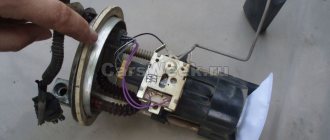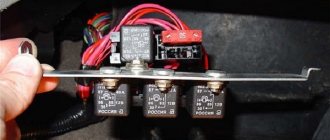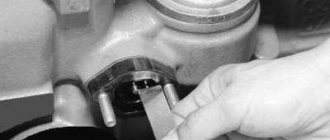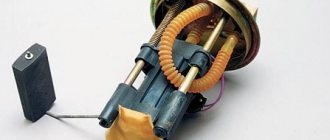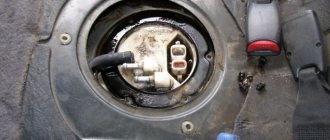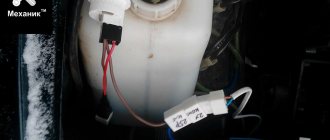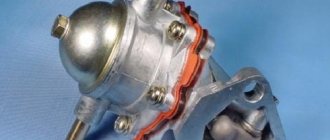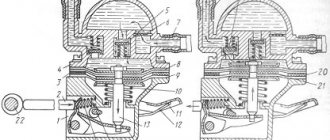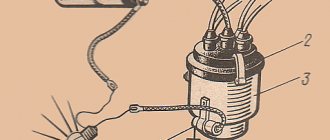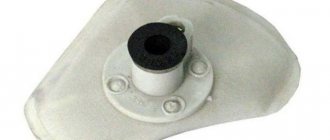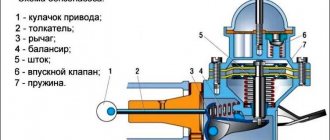On VAZ 2108, 2109, 21099, 2105, 2107 cars, fuel pump failure is a fairly common occurrence.
If it is faulty, the fuel supply to the carburetor is completely or partially stopped, which in some cases entails the impossibility of starting both a cold and a hot engine, the engine may also start and stall, and unstable idling is possible. If you suspect that the fuel pump is faulty, you should first check it. Let's look at this procedure using the example of their two most common types - DAAZ and Pekar. They can be installed on both rear-wheel drive and front-wheel drive vehicles.
1. Check the serviceability and operation of the entire fuel supply system.
Remove the fuel hose from the fuel pump discharge fitting. Press the manual fuel pump lever several times. If the fuel pump is working properly, a strong stream of fuel should spray out of it. If this does not happen, we carry out a second check.
checking the serviceability of the fuel system of VAZ cars
2. Check the serviceability of the intake valve.
Remove the fuel hose from the fuel pump suction fitting (we now have both fuel hoses removed from both fittings). We plug it with our finger and press the manual fuel pump lever several times. You should feel a vacuum on your finger (it should be sucked into the fitting). If there is a vacuum, the fuel pump is working; if not, look for a fault in the fuel lines or gas tank.
vacuum at the suction and discharge fittings of the fuel pump - checking the serviceability of the inlet and outlet valves of the fuel pump
3. Check the tightness of the exhaust valve.
Place your finger on the hole in the pressure fitting (which is connected to the carburetor) and press the manual pumping lever several times. A stream of air should come out of the fitting hole, which can be easily felt by your finger.
Causes of malfunction of fuel pumps of VAZ 2108, 2109, 21099, 2105, 2107 cars
The fuel pump strainer is clogged or deformed
Remove the fuel pump cover. We take out the filter. We clean it, wash it in gasoline, blow it with compressed air. We replace the deformed one.
DAAZ fuel pump fuel purification mesh filter
On the Pekar fuel pump and similar ones, you can remove the filter by unscrewing the suction fitting from the cap. The cover itself does not need to be removed.
The diaphragms are faulty (weak, cracked). Signs of their malfunction can be the presence of fuel leaks on the fuel pump body and the smell of gasoline from the engine oil in the engine. Although not necessary.
Remove the upper part of the fuel pump housing. We take out the diaphragm assembly. Unscrew the nut on the rod and remove the diaphragms (there are three of them). We replace them with new ones. We assemble everything in reverse order.
diaphragms (membranes) of the DAAZ fuel pump
There is only one diaphragm on the Pekar fuel pump. You can remove it by removing the cover. To disconnect, turn it 90 degrees.
Valves are faulty
Remove the fuel pump cover and strainer. Visually inspect the cavity of the fuel pump and the inlet valve. Remove the upper part of the housing and inspect the exhaust valve. If the valves are not hermetically pressed into the body, are not pressed tightly, or have lost mobility, the fuel pump must be replaced. If there is a blockage, remove it and blow everything out with compressed air.
inlet and outlet valves of the fuel pump of VAZ 2108, 2109, 21099 cars
On the Pekar gasoline pump, both valves are located in the cover and their condition can be assessed by removing it from its body.
The fuel pump pusher is worn out or deformed
Remove the fuel pump from the studs by unscrewing the two nuts securing it. We leave the gaskets, heat-insulating spacer and pusher in the engine. Rotate the crankshaft so that the pusher is recessed as much as possible. We measure the protrusion of the pusher above the plane of the upper gasket. It should be 0.8 - 1.3 mm. If the protrusion does not fit into this size, then we try to adjust it by selecting shims of either thinner or thicker thickness, or by changing the pusher.
measuring the amount of protrusion of the fuel pump pusher
We only change the outer thick gasket, which is between the thermal insulating spacer and the fuel pump. Gas pump repair kits are sold with ready-made gaskets, but you can also cut them yourself from a sheet of poronite.
Gaskets under the fuel pump
The spring under the diaphragms broke
We remove the upper part of the fuel pump housing, the rod with diaphragms and inspect the spring. We replace the broken one.
fuel pump return spring
Five more articles on the website on the fuel system of VAZ cars
The fuel pump of classic Zhiguli cars is one of the weak points of these cars. The mechanism causes a lot of problems for car owners, which is especially evident in hot weather. If problems arise with the fuel pump, you need to know both the reasons for their occurrence and how to fix them.
Gasoline pump for carburetor VAZ 2107
One of the mechanisms of the power supply system of any engine is the fuel pump. The startup and operation of the power unit directly depends on its performance. Mechanical fuel pumps of the diaphragm type DAAZ 2101 were installed on carburetor “sevens”. Thanks to the simple design, the mechanism is repairable. However, it often causes problems for Zhiguli owners. Therefore, it is worth dwelling on the operation and malfunctions of this unit in more detail.
Main functions
The job of the fuel pump is to move fuel from the tank to the carburetor.
The design of the unit is not ideal, so it is one of the weak points in the car. This is explained by the fact that the impact of constant loads and low quality gasoline lead to natural wear and tear of the elements. This is what causes the device to fail. If a problem occurs with the pump, the engine begins to work intermittently or stops functioning altogether.
Design and operating principle
The mechanism is made of several parts connected to each other by fastening elements. There are two fittings in the upper part of the body through which fuel is supplied and pumped into the carburetor. The design includes a lever that allows you to manually pump gasoline from the tank into the fuel system, which is important after the car has been parked for a long time. The main elements of the node are:
- pusher;
- spring;
- balance;
- lid;
- cover screw;
- screw;
- mesh filter;
- membranes (working and safety);
- lower and upper plates;
- stock;
- valves (inlet and outlet);
- manual pumping lever.
About the design
DAAZ fuel cells are installed on cars of the “classic” family. Specifically on the “seven”, the pump is capable of pumping fuel in a volume of up to 60 liters per hour. In this case, the pressure generated in the system is about 20-30 kPa.
The design of this element includes the following parts:
- Cover and cover screw.
- Mesh filter.
- Upper part of the body.
- Top plate.
- Screws connecting the body parts.
- Fastening nut.
- Working diaphragms.
- Stock.
- Bottom plate.
- Distance spacers.
- Manual pumping lever.
- Lower part of the body.
Signs of a fuel pump malfunction
An experienced car enthusiast can determine the malfunction of his car by its behavior or by extraneous sounds. This also applies to the fuel pump. If knowledge is not enough, it is worth considering the following characteristic signs indicating problems with the fuel pump:
- the engine does not start;
- the engine stalls almost all the time;
- the power and dynamics of the car decreases.
However, it is worth considering that power may decrease for a number of other reasons: problems with piston rings, valves, etc. If the fuel pump is completely faulty, the engine will not be able to start.
The fuel pump does not pump
There may be several reasons why the device does not supply fuel. Before you start troubleshooting, you need to make sure that there is gasoline in the tank. It happens that the level sensor shows incorrectly and the problem simply comes down to a lack of fuel. You also need to make sure that the filter elements are not clogged, but it is better to replace them, because they are inexpensive. After these steps, you can begin diagnostics.
The causes of problems may be:
- wear due to long mileage;
- diaphragm damage;
- insufficient spring stiffness as a result of stretching;
- valve contamination;
- violation of the tightness of the unit.
If the gas pump on the “seven” does not supply fuel, then there are two ways out of this situation: install a new device or disassemble the old one, carry out diagnostics and replace damaged parts.
On my car, a situation once arose that indicated a lack of fuel for the engine: there was no normal dynamics, the engine periodically stalled and would not start. There was enough gasoline in the tank, the filters were in good condition, but the car did not drive. After lengthy investigations and clarification of the reasons for this phenomenon, the problem was found: the fuel supply hose from the pump to the carburetor was swollen inside, which indicated the poor quality of the product. The internal cross-section has become very small and insufficient to pass the required amount of fuel. After replacing the hose the problem disappeared. In addition, I change fuel filters at least every 5 thousand km. mileage (preferably more often). I have them before and after the fuel pump. As practice shows, even with the installation of two filters, as well as with a mesh in the fuel pump itself and at the carburetor inlet, debris still penetrates into the float chamber. This results in the carburetor having to be cleaned periodically.
Video: VAZ fuel pump does not pump
Stops pumping when hot
One of the problems of classic Zhiguli cars is overheating of the fuel pump, which leads to a disruption in its performance - it simply stops pumping. The problem is caused by the formation of a vapor lock, which blocks the supply of gasoline. There are several ways to solve the problem: water the cooling pump with water or ride with a wet rag on it. These methods are applicable in a critical situation, but not for everyday use. The problem can be eliminated by adjusting the fuel pump using gaskets, replacing the rod, replacing the unit itself, or using higher quality fuel.
Checking the fuel pump
If there are suspicions or characteristic signs of fuel pump problems, the mechanism should be checked. To do this, perform the following steps:
- Loosen the clamp of the hose that supplies gasoline to the carburetor, and then pull the hose off the fitting. Gasoline will leak out of the pipe, so it is better to lower its edge into an empty container.
Replacement stages.
1. First of all, it is necessary to loosen the fastening of the fuel mixture supply and discharge hoses. To do this, use a Phillips screwdriver to unscrew the holders located on the clamps.
2. The next step is to remove the fuel conductors from the fitting. You should first prepare the bolts that will act as plugs. Of course, you don’t have to use bolts, but in this case most of the gasoline will spill out.
3. Next, unscrew the nuts that secure the pump. To do this, you will need a thirteen socket wrench.
4. After the fastening nuts have been loosened, it is necessary to remove the element from the racks and at the same time dismantle the sealing element.
5. The next step is to dismantle the heat insulation element along with the drive mechanism.
Before dismantling the second seal, it is worth first marking its position with a colored marker or other visible method. This will make the reinstallation process easier.
It is also important not to mix up the first and second seals.
Mechanical pump
6. Now, let’s begin installing the new original VAZ 2106 fuel pump. A working pump is installed in the complete opposite order. To increase the service life of a new fuel system element, it is worth periodically checking the adjustment of the sealing gasket. Correct shim adjustment is determined as follows. When turning the crankshaft, the drive that pushes the pump should protrude to a minimum amount. At this moment, we look at how tightly the gasket fixes the element.
Once the new pump is in position, the pump wire should protrude approximately one millimeter (plus/minus 0.2 mm).
Operation in difficult conditions
The optimal thickness of the gasket between the cylinder block and the heat insulation element is 0.3 millimeters (an error of no more than 0.03 mm is also allowed. The seal located between the heat insulation attachment and the pump itself is selected individually. Most often, this element is made by the hands of a car enthusiast.
As it turned out, replacing an element of one of the most important vehicle systems turned out to be quite affordable
The fuel pump is an important part of the engine fuel supply system
Given the importance of this component of the vehicle system, it is worth paying due attention to its maintenance. In most cases, the cause of fuel compressor failure is the use of a low quality fuel mixture. The presence of abrasive particles in gasoline leads to premature wear of the pump and other elements of the fuel system
The presence of abrasive particles in gasoline leads to premature wear of the pump and other elements of the fuel system
To increase the service life of the pump and other elements of the fuel system, it is worth regularly checking the condition of the fuel filter and replacing it in a timely manner
The presence of abrasive particles in gasoline leads to premature wear of the pump and other elements of the fuel system. To increase the service life of the pump and other elements of the fuel system, it is worth regularly checking the condition of the fuel filter and replacing it in a timely manner.
There are several types of additives designed to clean and prevent the fuel line, which can be used if the system is severely clogged.
Along with installing a new fuel pump, it is best to install a new filter element. In this way, premature wear of the element can be avoided.
The VAZ 2106 fuel pump is very picky about the quality of gasoline. Of course, the car will operate on low-quality fuel, but in order to avoid unexpected costs for car repairs and maintenance, we recommend filling up with gasoline at trusted gas stations.
https://youtube.com/watch?v=biMh-yL8gx0%3F
Good luck on the road!
Fuel pump drive
The VAZ 2107 fuel pump operates from a pusher (rod) and an eccentric located on the shaft of auxiliary devices (“piglet”, intermediate shaft), which is driven by the timing mechanism through a gear. Auxiliary devices include distributor, oil and fuel pumps.
Operating principle
The drive works as follows:
- the intermediate shaft rotates via a timing chain;
- the eccentric acts on the rod and pushes it;
- the rod presses the fuel pump lever, ensuring its operation.
Fuel pump drive malfunctions
As the fuel supply unit wears out, problems may occur that affect the performance of the latter.
Rod wear
The main sign of a worn-out rod is that the car does not reach the required speed. If the car accelerates, but, having gained speed to a certain value, does not develop it anymore, the reason is precisely the wear of the rod. Recently, the pusher has been made from such low-quality metal that it leads to wear out literally after 500–1000 km. The edge of the rod on the eccentric side is simply flattened, which indicates the need to replace the part.
Where is the fuel pump located on 2106, 2107 and other models
The location of the fuel pump on carburetor and injection classic VAZs is different. In the first, it is installed on the left (as viewed from the passenger compartment) on the engine cylinder block on a special boss, and is attached to it using studs through a heat-dissipating ebonite spacer. The mechanical fuel pump is driven from the engine intermediate shaft through an eccentric and a pusher (rod).
The mechanical fuel pump on the classic is mounted on a special boss on the engine cylinder block
In injection Zhiguli cars, the pump is included in the design of the fuel module. It is located inside the gas tank. The design of an electric pump consists of a DC electric motor and a specially shaped impeller mounted on its shaft. The electric motor is powered from the vehicle's on-board network. The electrical circuit of the device is protected by a separate fuse and relay.
The electric fuel pump on injection classic models is installed in the gas tank
Fuel pump repair
To replace or repair the pump, it will need to be removed from the engine. Tools you will need:
- 13 mm wrench;
- crosshead screwdriver.
Removing the fuel pump
We dismantle the unit in the following order:
- Wipe the pump with a rag.
- Disconnect both hoses (inlet and outlet) by loosening the clamps with a screwdriver.
- We pull the hoses from the fittings.
If you need to replace the rod, then simply remove it from the heat-insulating spacer and replace it with a new one.
Once a situation arose on my car when engine oil was leaking from the installation site of the fuel pump (in the area of the gaskets). It was not immediately possible to identify the cause. At first I made mistakes on the gaskets between the engine block and the spacer, as well as between it and the fuel pump. I replaced them, but did not achieve a positive result. After dismantling the mechanism again, I examined all the elements more carefully and discovered that the heat-insulating spacer had a crack through which oil was leaking. I had to replace it, after which the problem disappeared. In addition to the described case, there was a similar situation when oil was leaking at the location of the fuel pump. This time the pump itself turned out to be the culprit: oil was oozing from under the axis of the manual fuel pumping lever. There were two options to get out of the situation: accept it or buy a new product. I bought and installed a new pump (DAAZ), which to this day works properly and does not leak.
Disassembly
To disassemble the fuel pump you need to prepare:
- 8 and 10 mm wrench;
- Phillips screwdriver.
The disassembly procedure is as follows:
- Unscrew the bolt holding the top cover.
During assembly, the strainer must be installed so that its hole is above the valve.
Replacing valves
The VAZ 2107 fuel pump valves are included in the repair kit. To replace them, you will need a needle file and suitable attachments for dismantling.
The disassembly sequence is as follows:
- We remove the cores using a needle file.
Installing and adjusting the fuel pump
Installation of the fuel pump on the “seven” is carried out in the reverse order of removal. The process itself does not cause any difficulties. However, attention should be paid to the gaskets, since their thickness has a direct impact on the operation of the mechanism.
Adjustment of the position of the unit must be carried out if, after its removal, the gaskets were replaced or the old seals were strongly pressed in.
The fuel pump is sealed with several gaskets:
- adjustable (thickness 0.7–0.8 mm or 1.1–1.3 mm);
- thermal insulation;
- sealing (0.27–0.33 mm).
The adjusting and sealing gaskets differ only in thickness. There must always be a sealing gasket between the engine block and the heat-insulating element.
The fuel pump is adjusted as follows:
- Install the sealing gasket.
Video: how to adjust the fuel pump on a “classic”
Diagnostics and replacement of the electric fuel pump on cars of the Zhiguli family
In injection engines of classic VAZs, the fuel pump may lose its functionality both due to problems with the power supply to it and due to a malfunction of its electric motor. In the first case, the situation can be corrected by diagnosing and repairing the electrical circuit of the device. But if the electric motor of the pump fails, only replacing it will help.
Checking the protection devices for the electrical circuit of the fuel pump on injection VAZs of the Zhiguli family
If there is a problem with the electrical equipment of the fuel pump circuit, it usually does not turn on at all. Turn on the car's ignition without starting the engine and listen. First, you should hear a click from the relay, and then a characteristic “squeal” emitted by the pump’s electric motor. If you don’t hear anything like this, start diagnosing with the electrical circuit of the device.
The pump circuit is connected to the on-board network via a separate relay, and its protection is provided by a fuse. Both of these devices are located in the vehicle's optional mounting block. You will find it under the glove box. It contains 3 relays and 3 fuses. The fuel pump relay (indicated R2 in the diagram) is located in the middle, and the fuse (F3) is to the left of it. We pull the fuse out of its seat and check it by “ringing” it with a tester. If a malfunction is detected, we replace it, not forgetting to comply with the rating (15 A).
You can check the functionality of the relay by installing a known working device in its place. Instead, replace it with the relay located to the right of the one being diagnosed, which is responsible for the radiator fan circuit. If this option does not suit you, turn on the ignition and measure the voltage between the pink wire going to the relay and the vehicle ground. The device should show 12 V. This means that the device is powered. After this, you need to connect the pink wire with the gray one at the relay terminals. So we will connect the fuel pump directly to the battery. If it works (that same “squealing” sound will be heard), simply replace the relay.
The fuel pump relay is located in the middle (R2), and the fuse is located to the left of it (F3)
Checking the fuel pressure in the system
The main indicator of the operation of a fuel pump is the pressure it creates in the system. If the device turns on, pumps fuel, but the engine runs intermittently, take the time to check the pressure. To do this, you will need a pressure gauge with a measuring range of 5–7, equipped with a gas-resistant hose and a threaded fitting (if there is no special one, you can use a regular tire pressure gauge). The sequence of actions is as follows:
- On the fuel rail we find a fitting closed with a plastic cap. Unscrew the cap and connect the pressure gauge hose to the fitting. If your device is not equipped with a special threaded fitting, the hose can be secured to the “nipple” using a small clamp.
Pressure connection
The pressure in the ramp should be 2.8–3.2 atmospheres
When removing the vacuum hose from the regulator, the pressure should drop by 0.2–0.7 atmospheres
Replacing the fuel pump on injection Zhiguli cars
You can replace the fuel pump either as an assembly (install a new fuel module) or separately (change only the pump). The cost of a new domestically produced module with a fuel level sensor is 2800–3000 rubles. The production pump itself will cost 500 rubles less.
Replacement Tools:
- slotted and Phillips screwdrivers;
- key to 10;
- key to 7.
Work order:
- Disconnect the negative terminal from the battery.
- Open the gas tank cap.
- Using a slotted screwdriver, remove the rubber apron from the neck of the tank. Disconnect the safety valve tube from it.
Use a slotted screwdriver to pry off the apron
Unscrew the screws securing the gas tank trim
Unscrew the tank clamp bolt
Disconnect the electrical wiring, fuel line hoses, unscrew the nuts securing the fuel module cover
Removing the fuel module from the gas tank
Disconnect the fuel filter
Disconnect the pump power cables
Use a screwdriver to move the clamps and remove the pump from the casing.
Disconnect the tube from the outlet fitting
After installing the pump, it is advisable to check the pressure in the system as described above.
Replacing the fuel pump in cars of the Zhiguli family does not require the car owner to have extensive knowledge in the field of auto repair, and does not take a lot of time and money. It can be done without any problems in a garage, or right on the street. However, if you do not have the necessary tools or the desire to do this yourself, it is better to turn to specialists.
Electric fuel pump for VAZ 2107
Increasingly, owners of “classics”, including the VAZ 2107, are installing modern devices on their cars. So, the mechanical fuel pump is replaced with an electric one. The main goal of introducing an electric fuel pump is to get rid of the problems that arise with standard pumps. However, you need to understand that if on injection “sevens” such a mechanism is installed directly in the gas tank, then on carburetor cars it is placed under the hood.
Which one can be installed
As an electric fuel pump, you can install any device designed to work on fuel-injected cars on the “classic”. Based on reviews from Zhiguli car owners, Chinese-made pumps, as well as Magneti Marelli and Bosch, are often used. It is important to know that the product must provide low pressure . A standard mechanical pump produces about 0.05 atm. If the indicator is higher, then the needle valve in the carburetor will simply let fuel through, which will lead to it leaking out.
Installation of an electric fuel pump
To install an electric fuel supply pump on a carburetor “seven”, you will need a certain list of materials:
- tee 8x6x8 mm;
- fuel line for VAZ 2107;
- check valve from the "eight";
- 8 mm threaded fitting;
- clamps, blocks from Kalina for a four-pin relay (3 pcs.) with a fuse holder;
- the four-pin relay itself (3 pcs.);
- fuel jet (150);
- fuel return hose from the V8;
- wires;
- non-latching button.
We carry out the work in the following sequence:
- We lay the fuel pipe (return) parallel to the standard fuel line, securing it in the factory locations.
Video: installing an electric fuel pump on a VAZ 2107
Once the installation of the mechanism is complete, it will function according to the following algorithm:
- after turning on the ignition and pressing the pumping button, the pump is activated and pumps up gasoline;
- when the starter starts, the fuel pump turns on;
- while the engine is running, the pump is powered by a generator;
- after the engine stops, the operation of the unit stops.
Installation benefits
Owners of Zhiguli cars who have installed an electric fuel pump on their cars note the following advantages:
- an engine with such a device operates more stable at idle speed;
- when accelerating sharply, the car responds well to the pedal, there are no dips, which is not the case with a mechanical pump;
- when switching gears there is a smooth ride, and when the gas is abruptly released there is no twitching;
- at high speeds the engine spins better;
- there are no jerks at low speeds when starting the car after a long trip.
The VAZ 2107 fuel pump sometimes has to be repaired or replaced. Doing this is not as difficult as it might first seem. Repair and adjustment work is carried out with a minimum set of tools in accordance with step-by-step instructions.
Regardless of the type of fuel for which the car is designed, it must be supplied to the engine uninterruptedly. Its reliability and stable operation directly depend on this. The quality of domestic gasoline traditionally leaves much to be desired - most engine mechanisms and systems suffer from this, primarily the fuel pump. To prevent it from breaking down at the most unexpected moment, you need to know the signs and causes of the malfunction, and also adhere to preventive measures to maximize the life of the gas pump.
Symptoms that clearly indicate a faulty pump and rod
Fuel pump and gasket set
The main sign of a faulty fuel pump is that the engine begins to stall at high temperatures, and after stopping it does not start. It sits for a while, cools down, and only then is it possible to start the engine. Of course, another breakdown has a similar symptom - a violation of valve adjustment. Only in this case does it feel as if the engine is trying with all its might to pull the car, but cannot, it is beyond its capabilities. And when the fuel pump starts to malfunction, the engine simply stalls.
The reason for this is excessive heating. As we said, the VAZ 2101 fuel pump consists of two valves. Well, one or both became warped due to heating and stopped opening. Cool them slightly and you can continue moving. Remember how often you saw a wet rag thrown over a gas pump? Now you know what purpose this is for.
But there is also a VAZ 2101 fuel pump rod, a truly wonderful contraption. It is made of steel. And if in the Soviet years it was hardened, now no one needs it. The price of the stock is at least 25 rubles. Well, who will spend kilowatts of energy on a part whose final cost is 25 rubles? Nobody! What happens then? But an unpleasant picture emerges - the fuel pump lever simply erases the rod, reducing its length.
And if you have gaskets under the fuel pump housing, then you are just lucky! When you pull one out, the rod will protrude from the insert more. And that’s it, the pump will continue to pump gasoline normally. But what if there are no gaskets? Who knows what could happen, for example, they forgot to put them on? And that’s why the rod was worn out. What to do then? Try taking it out and inserting it the other way. You know, this action helped several times.
A sign that the fuel pump rod has worn out is that the car accelerates to a certain speed. I had such a thing that I drove around the city normally, but as soon as I got on the highway, my maximum speed was 90 km/h, and that’s all. You step on the gas, but the engine stalls, it doesn’t have enough gasoline. I released the pedal a little - it drives calmly and shows no signs of breakdown. Moreover, a pump rod malfunction cannot always be detected when driving around the city or at idle speed. A short-term increase in engine speed will not give the same effect as long-term driving at high speed.
Purpose and principle of operation of the fuel pump
The fuel pump is designed to pump fuel from one point to another. In a car, the role of the first point is played by a fuel reservoir - the tank, and the second - by the engine, where the pumping takes place. This process occurs at a certain pressure, which is maintained by the pump reducer, which is a very important point.
Fuel pumps are divided into 2 types according to the type of drive: electric and mechanical. Inside the first there is an electric motor with a mini-pump, which operates from the mains and uninterruptedly pumps fuel into the engine. The second type is becoming increasingly rare, as it is installed on carburetor cars, and operates due to the reciprocating movement of the lever.
What is the device
The gasoline pump is a cylindrical barrel measuring 20x15 cm, located under the hood of the car in the carburetor area. It has two tubes, one of them pumps gasoline, and the other supplies it to the carburetor. It also has a lever that is designed for manual pumping of fuel if the mechanical system is not functioning.
The design of the device includes:
- The chamber into which fuel flows from the tank.
- Fuel inlet and outlet valves.
- Diaphragm.
- The ghost lever operates the pumping mechanism.
- Return spring.
- Fist.
- Camshaft
- Sealing gasket.
The operating principle will tell you what each part does.
Signs of a fuel pump malfunction
Mechanical fuel pumps
In a mechanical fuel pump, malfunctions most often occur due to wear of the sealing gaskets and the formation of leaks between parts of the housing. As a result, the tightness of the structure is broken, air gets in, fuel stops getting into the carburetor and the engine stalls. A similar consequence is caused by membrane rupture and valve failure. At the same time, the car begins to move jerkily until the fuel supply stops completely.
Electric fuel pumps
On cars with mechanical and electronic injection, the signs of a fuel pump malfunction are slightly different, but they can be classified into certain groups:
- The engine does not start. Rotation of the starter with dry spark plugs does not cause flashes in the cylinders. There is no pressure in the fuel line, or it is extremely low; the buzzing of the pump is not heard when the ignition is turned on or the starter is operating.
- The engine does not start, although occasional flashes occur in the cylinders. There is pressure in the fuel line, but without a pressure gauge its value cannot be determined. The candles are dry.
- The engine starts and idles normally, but pressing the accelerator causes it to stop. If you want, it is possible to raise the speed to medium, but attempts to start lead to the engine stalling. There is a black coating on the spark plugs, the operation of the fuel pump is characterized by a changing sound.
- The engine starts, holds idle speed normally, and picks it up easily at neutral speed. When driving at medium and high speeds, a “twitching” is observed. It happens that after a certain mark on the tachometer the speed does not pick up, and the engine stops producing the required power under load. At the same time, the spark plugs are white, and by their appearance it seems that the car is ignited too early or has a lean mixture.
It is worth noting that the above symptoms of fuel pump malfunctions are also typical for other engine breakdowns, and they cannot be used to unambiguously diagnose a fuel pump malfunction. For example, speed also fluctuates if there is a problem with the air sensor, throttle valve, clogged injectors or poor quality fuel.
Possible causes of fuel pump malfunction
Mechanical fuel pump disassembled
A mechanical fuel pump may fail for the following reasons:
- If the integrity of the diaphragm is damaged.
- After dirt accumulates under the valves.
- When the filter is clogged.
- When the spring loses its elasticity.
- If the seal of the housing is broken.
- Due to natural wear and tear of parts during operation.
The electric fuel pump of a modern car is quite reliable. Malfunctions in it arise only due to the influence of certain factors, among which the most common are the following:
Burnt contacts inside the fuel pump
1. Faulty wiring in the form of dirty, rusty, melted or damaged wires in the fuel complex interferes with the operation of the device and also limits the required current parameters, making it difficult to pump fuel.
2. Debris and foreign impurities in the fuel tank in the form of rust, dirt, water, mechanical particles that penetrate the fuel pump and cause its breakdown.
Clogged fuel pump filter
3. A clogged fuel filter with debris from the tank contributes to a sharp decrease in the pressure created by the pump and a deterioration in its operating parameters.
Melted fuel pump turbine
4. Driving a car for a long time with a small amount of fuel, during which the pump is not immersed, experiences significant overheating, quickly consumes internal lubricant and fails.
5. Natural wear of the rubbing parts of the pump.
Checking the fuel pump
The operation of a mechanical fuel pump is checked by disconnecting the hose from the manual pumping outlet, after which the lever on the pump pumps fuel, which, if there are no breakdowns, should be supplied in a stream in time with the movement. During the procedure, place a rag under the pipe to prevent gasoline from spilling in the engine compartment.
Checking for faults in the electric fuel pump is carried out in the following ways:
Checking the filter on the electric fuel pump
1. Check the filter. Most often, problems with the operation of the device arise when the coarse filter is clogged, which is characterized by the appearance of the following symptoms:
- Decrease in engine power;
- Weak traction at high speeds;
- Difficulty starting the engine;
- Unstable operation at idle and low speeds.
Checking the fuel rail pressure
2. Checking the pressure in the fuel line, based on the results of which you can more accurately determine the problem with the pump:
- At idle speed the pressure should be 0.23-0.25 kPa;
- When starting the engine, the pressure should reach 0.3 kPa;
- In transition mode – 0.28-0.3 kPa.
If in transition mode the pump does not produce the required pressure, then there is a high probability of clogging of the coarse filter mesh. If the pressure in the fuel line when the return pipe is pinched does not reach 0.4 kPa, this means that the degree of wear on the pump is quite high.
3. Check the pump for mechanical damage. If the pump mechanism is significantly worn or dirt gets into it, a characteristic noise will be heard. When the ignition is turned on, the fuel pump works, but with obvious signs of a malfunction of the mechanism.
Repair
Mechanical fuel pump repair
Repairing a mechanical fuel pump consists of installing a new repair kit (diaphragm and valves) and, if necessary, a worn pusher with a spring. A deeper repair of this device is impractical, since the costs of purchasing and repairing worn parts are close to the cost of a new product. If the pump housing is deformed or damaged, it must be completely replaced.
Electric fuel pump repair
The electric fuel pump is equipped with a non-separable housing, and if it breaks down, the product is replaced with a new one. Without special skills, equipment and spare parts, opening and repairing it is impossible. But some workshops undertake similar work, the price of which is lower than buying a new pump. The main failures of the device are as follows:
- Damage to brushes and motor commutator. Repair involves replacing them with new ones.
- Breakage of the plastic coupling connecting the rotor and the motor armature shaft. The clutch is replaced with a new one.
- Anchor failure. The repair involves rewinding this part.
The described actions allow us to eliminate the gas pump malfunction on all models of the VAZ: 2101, 2102, 2103, 2104, 2105, 2106, 2107, 2108, 2109, 21099, 2110, 2111, 2112, 2113, 2114, Niva, Priora, Kalina, Grant, Vesta and most foreign cars.
Cleaning and checking parts
Now let's start cleaning and checking. It is best to thoroughly rinse everything with kerosene and dry it; you can also use an ultrasonic cleaner. It is important to get rid of dirt that hides possible damage and can interfere with the operation of the pump.
We carefully monitor every part:
- strainer - if there are no cracks, there are no larger holes - the mesh must be uniform for proper operation;
- sump glass - cracked or cracked - such defects entitle you to replacement;
- valves - they should not have signs of wear on the contact surface of the elements - it is best to wash them well, dry them and check them by putting them in your mouth and blowing on both sides - blowing on one side should not allow air to pass through, and on the other hand the pressure should cause the valve to open and flow - if it is not there, the valves should be replaced with new ones. For dismountable valves where minimal wear is visible, laminate or bakelite tiles can be repaired by sanding them down with a smooth sheet of fine sandpaper. In addition, of course, you cannot break the valve springs.
- membrane - must be elastic, without cracks or signs of old age. Abrasions on the edge of the bolt holes also indicate that it is time to change it - due to overstrain, it can quickly burst.
- lever and diaphragm arm - at the points of contact of the arm with the diaphragm cable and the lever with the cam, the material consumption should not exceed 0.5 mm. The wear of the bushing, axle and lever hole is shown in the table below - if they exceed the permissible value, contact a lathe who will pull out a new bushing and pin;
- Springs - Both the lever spring and the diaphragm spring should be free of cracks, corrosion or wear.
Preventing fuel pump breakdowns
The best prevention for long-term operation of the fuel pump is its careful and proper operation, as well as compliance with the following rules:
- All scheduled vehicle repairs must be accompanied by the replacement of all fuel filters.
- It is necessary to monitor and ensure the cleanliness of the fuel tank and filters, as well as monitor the quality of the fuel being refilled (the absence of water, sand and other impurities in it).
- Eliminate the possibility of water getting into the fuel tank.
- Protect the fuel pump housing from mechanical stress that causes dents and cracks that contribute to the development of corrosion processes.
